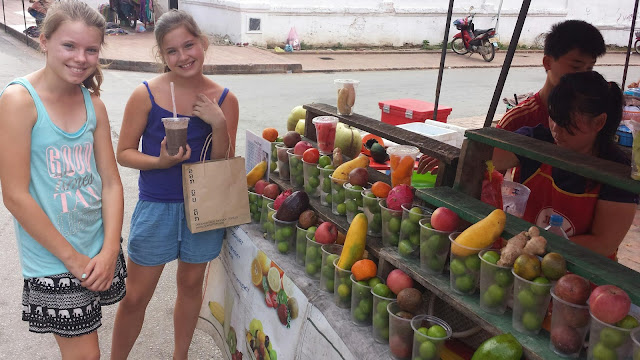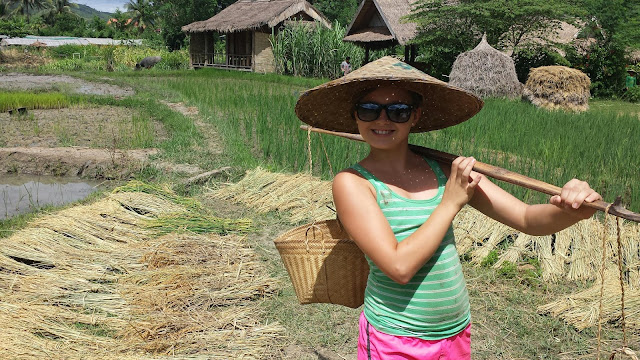Tuesday, June 30, 2015
It's a small world after all
The origin of silk
Day 49: Alms Ceremony
Tie die
Last day in Laos
Monday, June 29, 2015
Day 48: Kuang Si Waterfalls
Sunday, June 28, 2015
Day 47: Hanging Out
Another sleepy day in Luang Prabang. We woke up late (read: Abby slept until 10:00am when Beth woke her up "I've been up for 4 hours and I'm going crazy!"). It's Sunday so... Well, we've kind of lost the meaning of days, so it really doesn't matter what day it is!
We walked around town quite a bit - strolling along the shaded street that runs next to the Mekong. It was very quiet there and we watched locals going about their business. We walked by a group of men offloading pigs from a boat to a truck, and those pigs were NOT happy - the girls were slightly traumatized, but I didn't hear anybody swearing off bacon.
We walked down a set of concrete stairs that led down to the river, and I was a little shocked to see a measuring stick going all the way to the top of the stairs that ended at 15 meters above the river - does the river really get that high? I will have to research.
After lunch, the girls were whisked away to do some tie dye craft, so I hunkered down trying to get my lengthy blog from yesterday posted. I've been asked how I get blogs posted virtually every day, and up until now, it's been very easy. There has been wifi at every hotel and virtually every restaurant we have been to in Southeast Asia. I've also bought a local SIM card and data access packages at every country except Japan. This has been very useful for GPS mapping and looking up reviews for restaurants and activities.
The last few days has been hard to get pictures to upload, as for blogs, it's "all or none" when it comes to uploading a file, whereas YouTube videos can upload slowly and incrementally so they usually eventually work.
But I digress, I went to a restaurant and finished a longish blog, then headed over to the national museum that also has this beautifully constructed temple on the grounds.
Saturday, June 27, 2015
Day 46: Rice is Life
In light of that, we signed up for the "living land" half day workshop. We were picked up at 8:00am and driven out of town about 20 minutes to a beautiful farm at the foot of a small range of hills. The farm is 20 acres and supports seven families with over fifty people as well as a bunch of students from hill tribe areas that have come to work, learn English and get an education.
There was a group of about sixteen or so tourists, so we split into two groups. Both guides had excellent English and definitely knew their way around the farm! So we began. Our guide walked us through the 13 step process from seed to mouth.
Step 1 - Seed selection: This was pretty interesting. They add salt to a volume of water, using an egg to test the salinity level of the water (once it stands up in the water, the water is salty enough). The rice grains are added to the water - the good seeds sink and the bad ones float. You skim off the bad seeds from the top and use them as feed for the animals (nothing is wasted!). To produce 4000kg of rice, you need just 30kg of seed. On this farm, they have enough water from the mountains to,do,two harvests a year - one they plant in July and harvest in October (that's the slower growing, higher yielding crop), then a winter crop planted in January and harvested in May (faster growing, lower yielding).
Step 2 - Germination - The good seeds are spread out on moist, muddy areas and left for a week to begin the germination process. Once small chutes pop out of the seeds, they are moved toms different area to let the chutes develop into a seedling. That takes up to 20-30 days. This step was one of the missing links for us - we have often seen farmers planting chutes, holding a big bunch in one hand and picking one out and planting them with the other hand.... But where did they get all the chutes! Ahh... City folk....
Step 3 - Preparing the Field - Have I mentioned that this workshop was hands on? Oh yes. In fact, that's spelled out in advance, so we found it pretty laughable that one person complained on Trip Advisor that "this place is a tourist trap, they trick you into doing all the labour for them while they sit around and watch!". Too funny, I'm sure we are not quite as effective at the job as the farmers are. So we all got our chance to plough the field behind a water buffalo. Walking through the cool, wet mud while being dragged by Suzuki (Rudolph was with the other group and was nowhere near as cute as our little Suzuki) was pretty fun. Admittedly this farm uses a guest Buffalo (power tractor) to plough their big feels nowadays, but seeing an animal driven plough like this is very common in SE Asia.
Step 11 - Sifting - Now we're getting somewhere. A woman from the farm demonstrated how to use a flat bamboo sifter to get rid of unwanted husks and seeds that were not yet separated. After two minutes she grabs a bowl, flips the sifter in the air and the bowl magically fills with pure white rice! Apparently every woman needs to get good at sifting rice, as it is one of the factors the men use when evaluating a good mate! I had Beth try the sifter and....well... we're already married.
Step 12 - Preparing the Rice - Getting hungry! We were told of the importance of soaking the rice (the rice we were making was sticky rice so very important). It should be soaked for at least three hours. Luckily our rice was already cooking! Interestingly, they don't dispose of the water they soak the rice in, they use it for shampoo!
Step 13 - Cooking - This sticky rice was simply steamed. It was placed in a bamboo sieve, covered and placed over an open fire with a pot of boiling water. Thirty minutes and it would be ready to eat!
Grinding Rice Flour - We tried our hand at making rice flour. We used a wooden mechanism hooked up to two grinding rocks. The flour would take a lot of refinement as it took a bunch of passes to make a very fine grain flour. The flour is used to make rice noodles, rice paper, yeast for rice wine and many more things.
Welding - We used a bamboo gadget that fed air to a fire pit like a forge and watch as the blacksmith used pieces of rebar to make a sickle and a substitute buckle for a wooden case... Pretty cool that they can do so much with very little.
Bamboo weaving - we watched, mostly, as one of the older guys took a bamboo chute and made all kinds of crafts and kitchen implements.
We were ready to eat! They served us up a whole wack of rice and rice flour products, and we had rice wine and Jaew Bong (a very tasty chilli dipping paste) to round out the snack.
The experience was great - we learned a ton, answered a lot of the kids past and future questions about rice(!) and met a bunch of nice people on the way. No rice, no life indeed.
Friday, June 26, 2015
The village in Mekong river
Day 45: Chilling in LP
Nothing on tap today, which is just fine. Beth woke up early (she's really going octagenrian on us with her sleep and awake times) and got us some baguettes, cheese, yogurt and peanut butter - it was well received. Of any meal that we miss having at home, it's breakfast - hands down. The Tyndalls are big breakfast fans, and getting some nice whole wheat bread, coffee with milk (for Beth) and peanut butter has been sorely missed. Hell, throw in a Venti Skim No Foam Chai and now we'd have us some breakfast. Well, no Starbucks in Laos, but today we had a pretty good breakfast - thanks for getting up early Grannie!
Late morning, we took a different route to town, this time along the side of the bicycle and scooter only bridge.
























































